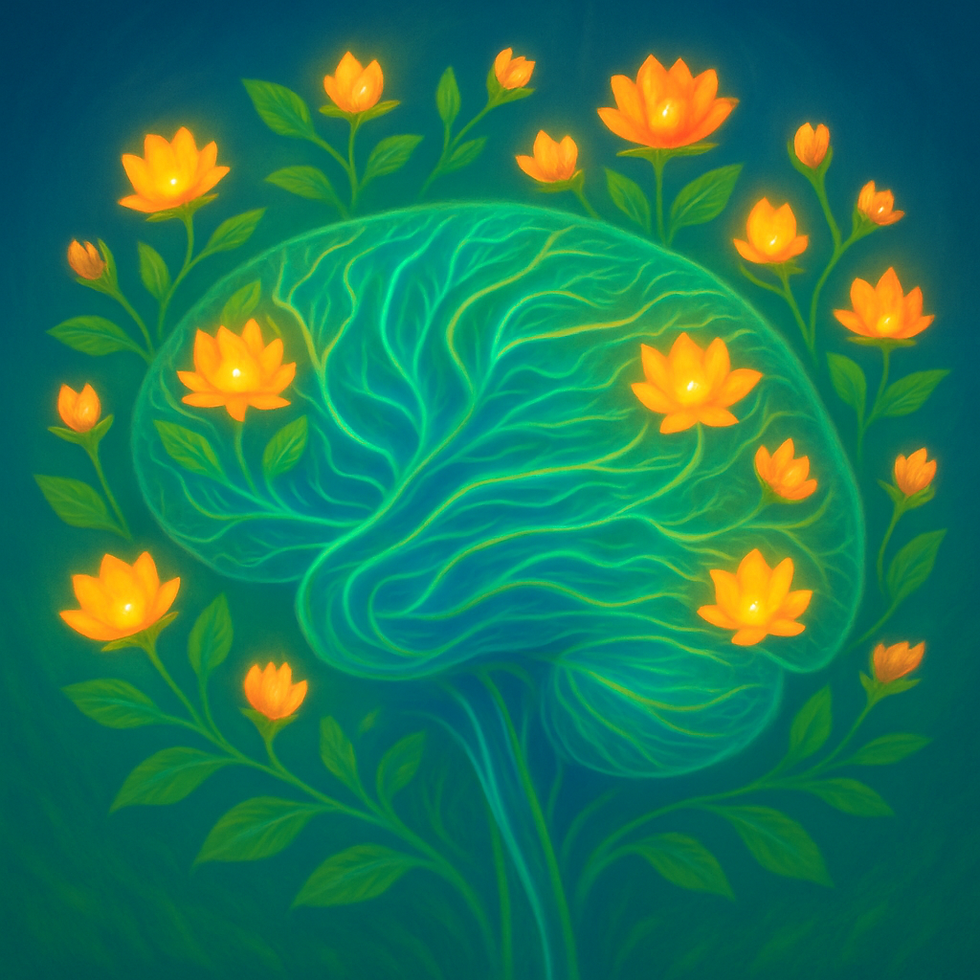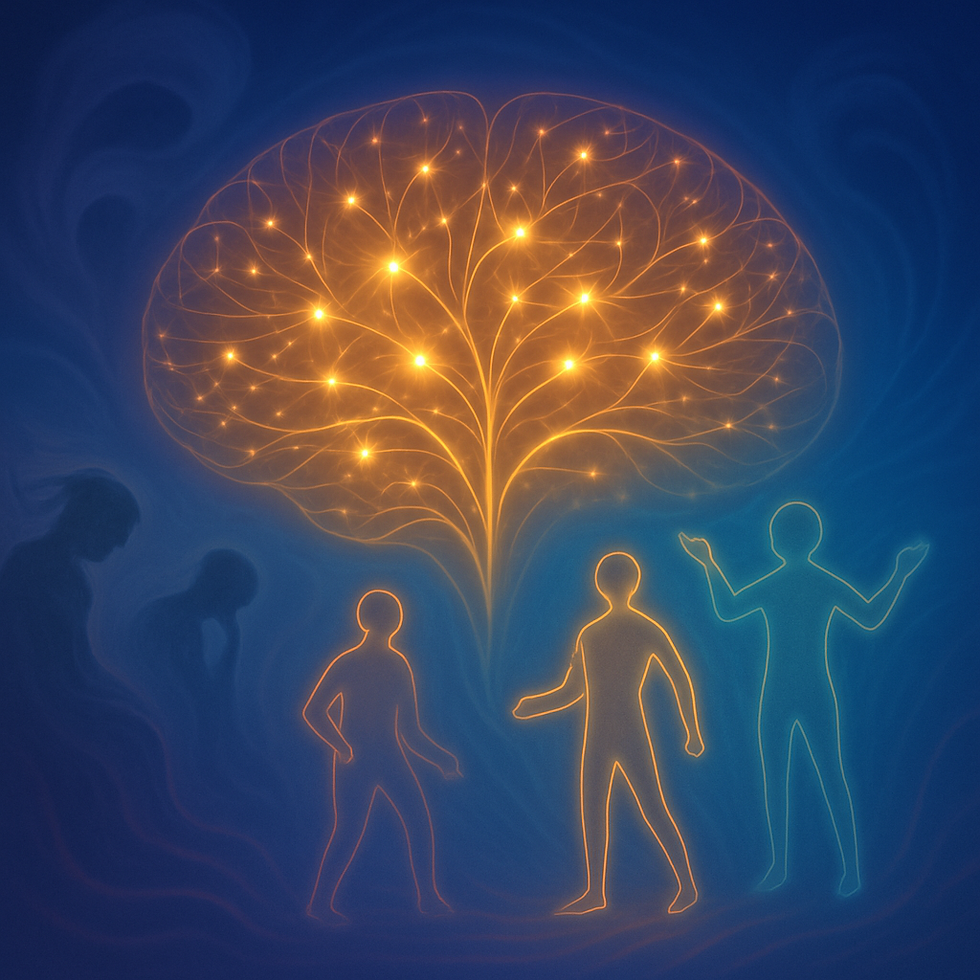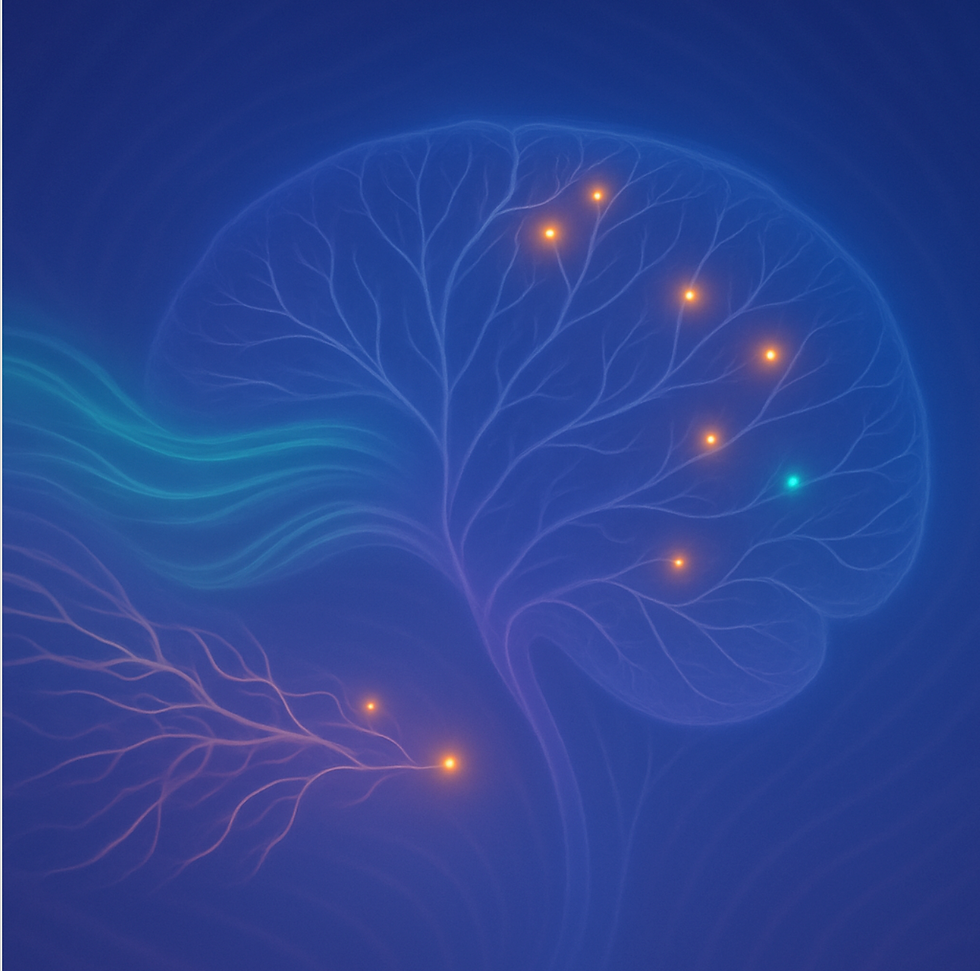Catalysts of Change: How Timing Supercharges Ketamine-Assisted Therapy and Why This is Important for Queer and Non-Monogamous Clients
- Sarah Wolfer, LICSW

- Aug 5
- 7 min read
Written by Sarah Wolfer, LICSW
Courageous You Founder
At Courageous You, my mission is to nurture healing and authentic self-expression especially for those whose lives unfold at the vibrant intersections of queerness, non-monogamy, neurodivergence, kink, and complex trauma. I offer ketamine-assisted therapy not just as a tool for symptom management, but as a pathway to deeper truth, agency, and liberation.
Ketamine creates a unique, time-limited “window” in the brain; a period when old knots can loosen, new connections can form, and the possibilities for change become brighter and more attainable. When this opportunity is paired with care, intention, and affirmation, profound growth is possible.
Curious about the science behind this transformation, and how this process can uniquely support your journey? Let’s explore what actually happens in your brain and how we can use that knowledge to foster lasting, meaningful change.

Why Ketamine Works Differently
Unlike traditional antidepressants that slowly adjust chemical levels, ketamine rapidly increases neuroplasticity; the brain's ability to form new connections and release old patterns. This matters for anyone whose nervous system has been shaped by chronic stress, identity suppression, or relational trauma.
For my queer and non-monogamous clients, this can include:
Undoing internalized shame or erasure
Loosening survival strategies like masking or hyper-independence
Making space for new relational scripts that center consent, complexity, and self-trust
Releasing embodied fear responses tied to identity-based harm
Shifting from relational hyper-vigilance to co-regulation
Expanding tolerance for joy, rest, and play
But here’s the thing: the benefits of ketamine aren’t automatic. They depend on timing, support, and intention. Let’s dive into what that means for your ketamine-assisted therapy journey.
The Neuroplasticity Window: How Timing Supercharges Ketamine-Assisted Therapy
Ketamine rapidly initiates a cascade of brain changes that open a unique window for transformation. Aligning integration with these phases amplifies the potential for lasting change.
Phase 1: Spark (0–30 Minutes Post-Dose)
Mechanism: Ketamine acts as a noncompetitive NMDA receptor blocker, causing a surge in glutamate release. This cascade leads to rapid upregulation of BDNF and triggers mTOR signaling, both critical for neuroplasticity.
Experience: People often feel dreamy, emotionally open, sometimes detached. This initial detachment is thought to relate to the reduction of entrenched defensive wiring.
Integration Tip: Gentle environments such as soft music, low lights, trusted support allows you to stay present without any pressure.
TLDR: This is when the medicine first starts working, opening your mind and softening your usual defenses. You may feel floaty or emotional, and that’s okay, just let yourself be.
Phase 2: Peak Plasticity (~2 Hours Post-Dose)
Mechanism: By two hours, the brain's “plasticity potential” (its readiness to form new synaptic connections) roughly doubles. Research shows that glutamate-evoked formation of new dendritic spines peaks here.
Clinical Markers: This period marks the early behavioral transition, as acute dissociation subsides and the antidepressant effects begin to emerge.
Integration Tip: This is a powerful window for planting new insights or gently challenging outdated beliefs. You might be more open to questioning inherited scripts and self-worth narratives, as old patterns are more malleable.
TLDR: Your mind is extra open to new ways of thinking and feeling. This is a good moment for new ideas or gentle self-reflection where change feels possible and real.
Phase 3: Sustained Receptivity (~4 Hours Post-Dose)
Mechanism: BDNF protein levels peak, and mTOR signaling actively supports synaptic protein synthesis laying the groundwork for lasting structural changes.
Experience: The brain absorbs and “remembers” integration work here. New ideas, if introduced, can take root and be reinforced.
Integration Tip: This is a prime time for soft, supportive therapy, journaling, mindful movement, and guided meaning-making. Integration sessions should be focused but not overwhelming, reinforcing new insights while the brain is highly receptive.
TLDR: Your brain is soaking up everything like a sponge. If you want to remember something important, or anchor a new idea, now is a powerful time to do it.
Phase 4: Closing Window (Up to 12 Hours)
Mechanism: The intense neuroplasticity window tapers off by 12 hours post-dose, although the brain remains sensitive and continues to integrate new material.
Integration Tip: Recognize that the brain is transitioning from rapid growth to a slower phase of consolidation. Gentle reinforcement and reflection are key as you process and stabilize insights.
TLDR: The big burst of openness is fading, but you’re still gently absorbing and processing. Take it easy and let things settle in.
Phase 5: Structural Shifts (24–72 Hours)
Mechanism: Clinical effects peak during this window. Behavioral and mood shifts become more noticeable as new synaptic connections are woven into existing brain circuits.
Experience: Clients report lifted mood, increased flexibility, and a softened view of self-criticism and anxiety.
Integration Tip: Try out practical experiments such as setting healthy boundaries, redefining self-narratives, or practicing new relational behaviors. Therapy can help anchor these shifts and avoid regression to old habits.
TLDR: You might feel lighter, happier, or more able to try out new ways of thinking or relating. These changes often feel more natural during this time.
Phase 6: Long-Term Consolidation (1–2 Weeks+)
Mechanism: Newly formed pathways stabilize, and the brain continues to “practice” and consolidate changes. Depression relief and increased psychological flexibility can last for 1–2 weeks or more.
Integration Tip: This phase is about practice and reflection.This is the moment to reinforce new habits, relational patterns, and rewritten self-stories through ongoing journaling, therapy, or group support.
TLDR: This is when your changes really settle and become part of you. It’s a great time to try out new habits and continue practicing what you’ve learned.
Ketamine Integration: Why It Matters
Evidence shows that combining ketamine with integrative psychotherapy, such as what I offer here at Courageous You, significantly boosts and extends therapeutic outcomes, compared to ketamine alone. Mindfulness, guided reflection, movement, and supportive social contexts are especially effective during the neuroplastic window, not only helping to “lock in” change but also reducing the likelihood of regression as the window closes.

Practical Suggestions for Clinicians and Clients
Immediately post-dose: Offer a nurturing, low-stimulation environment. Avoid analysis; just presence.
2–4 hours post-dose: Use open-ended integration such as gentle questions, journaling, or guided imagery to reinforce positive insights.
12–72 hours post-dose: Anchor gains with supportive therapy, goal-setting, or relational updates.
Over the next 2 weeks: Check in regularly, support ongoing practice, and tailor integration to emerging needs.
Why This KAP Approach Matters for Non-Monogamous and Queer Clients
Cultural traumas like homophobia, mononormativity, transphobia, and other forms of oppression profoundly shape how our nervous systems learn to approach connection, trust, and intimacy. These experiences can plant deep-rooted messages that teach us to fear closeness, default to people-pleasing, or shut down our true feelings in order to survive.
Ketamine’s neuroplastic window doesn’t erase this history, but it offers a powerful opportunity to gently rewrite these internalized patterns.
In a supportive, affirming environment, ketamine therapy can help you:
Feel empowered to question old power structures and dynamics both in your relationships and within yourself.
Experience relief from shame or secrecy around your desires, relationship style, or gender identity.
Access a deeper sense of embodied consent and the freedom to feel more joy in your relationships.
Move through grief, anger, or pain without being overwhelmed or defined by them.
Our model is not about pushing you toward monogamy or setting healing on a straight path. Instead, we offer tools, time, and care to help you reclaim your most authentic self at your own pace, and on your own terms.
What to Expect from Courageous You’s Ketamine-Assisted Psychotherapy (KAP) Program
Our Ketamine-Assisted Psychotherapy (KAP) program is thoughtfully crafted to align with your brain’s neuroplastic timeline and center your unique story, relationships, and healing goals. I partner with Journey Clinical for safe and streamlined medical clearance and prescriptions, while I personally guide you through all phases of therapeutic preparation and integration.
Our program offers:
Personalized Preparation: Sessions designed around your relational landscape, lived identities, trauma history, and deepest intentions so you feel truly seen and supported.
Dosing Support: Virtual sessions held in the comfort and privacy of your home, ensuring safety and connection throughout your journey.
Timely Integration: Integration sessions the day after dosing, intentionally timed to maximize the brain’s window for growth and healing.
Somatic & Relational Tools: Practices that help you process insights not just in your mind but through your body and nervous system, deepening and embodying your progress.
Affirming, Lived Experience: Care from a therapist who understands non-monogamy, queerness, neurodivergence, and kink, not just as concepts, but as lived realities. You’re met with full affirmation and genuine understanding, every step of the way.
Choose a path that suits your needs:
Individual KAP: Deeply personalized, one-on-one therapy.
Relationship KAP: Explore growth and healing with one or more partners present.
Self-Guided with Integration Coaching: For self-starters who want supportive guidance at key moments.
Retreat-Style Intensives (in Mexico): For existing clients seeking immersive, transformative experiences.
Every aspect of the Courageous You program is trauma-informed, affirming of your important identities, and designed to help you foster courage, connection, and authentic change.

Bottom Line: The Timing Is the Treatment
You are worthy of healing that goes far beyond just easing symptoms. You deserve support that honors your full complexity; your relationships, your identities, and your power to grow beyond the limits and stories imposed on you. When ketamine-assisted therapy is thoughtfully timed and guided with care, it becomes a catalyst for real transformation.
Let’s harness your brain’s natural rhythm for change and create space for healing that is truly yours; on your terms, in your own time, and in deep alignment with who you are becoming.
Ready to explore KAP with us? Learn more and book a free consultation by emailing sarahwolfer@courageousyou.us




Comments